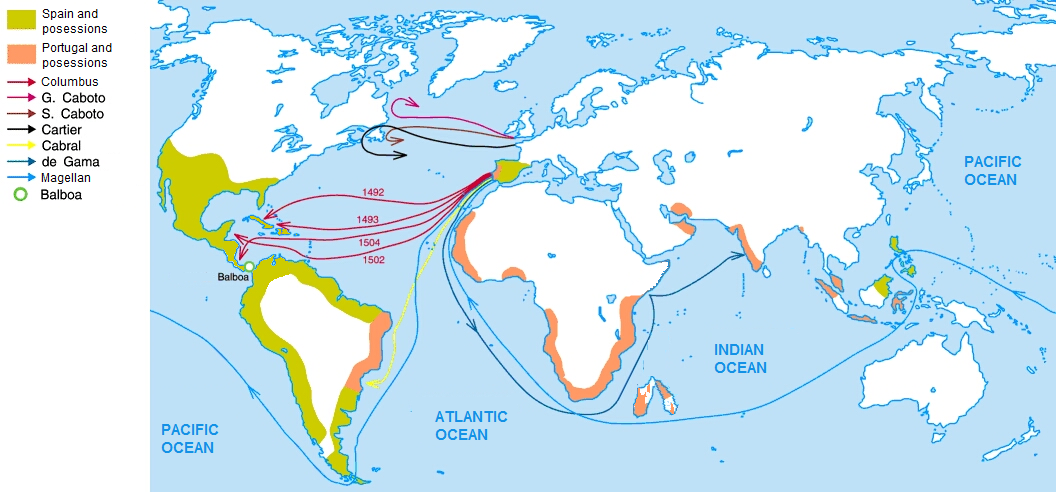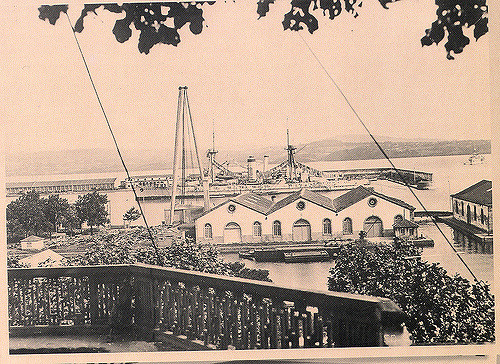
The news of an island bigger than some European countries being discovered off the coast of Africa slowly percolated through the seafaring countries. Money was being raised to send expeditions to explore for minerals, gems and any other valuables that could be found. Others were being offered warrants by the Portugese Government to settle the land and claim it for Portugal. Over the next 50 years, expeditions and colonisation parties were sent from all of the major European countries. Substantial towns arose and within ten years became ghost towns as strikes of precious metals are found and quickly depleted.
Slowly permanent settlements were erected on both the western and eastern sides and finally the small city of New Porto was designated the capital. Situated on the isthmus between the western and eastern land masses, it was in a prime position to oversee both sides. Regional governors had to be employed as the area was too large for easy governance. Corruption was rife, and it was not until the first ‘Algarve Navy’ vessels were deployed in 1575 that corruption started to be brought under control. Anybody not toeing the government line ended up swinging at the end of a yardarm or the nearest tree. A Navy carrack entering harbour with its yardarms full of dead bodies certainly gave some people pause for thought before trying to outwit the Governors.
The 17th and 18th centuries were periods of revolution and change for Algarve as the European countries fought their wars. When Portugal was assimilated by Spain in 1580 and not restored till 1668, Algarve, among other Portugese possessions, were fought over by other European nations with the Dutch, French and English prevailing and taking over governance. For Algarve, it was first the French, then the Dutch, then the English that took over Algarve by force. Not many people realise that the Anglo-Portuguese Treaty of 1373 signed between King Edward III of England and King Ferdinand and Queen Eleanor of Portugal is the oldest active treaty in the world. It established a treaty of "perpetual friendships, unions [and] alliances" between the two seafaring nations. Which also meant that when Portugal regained its independence from Spain, that Portugal and England would run Algarve jointly. Some of the city/town names, during this period, had become Anglicised and remained that way. New Porto had become Newport and that remained the capital of Algarve, even till this day.
Population growth for Algarve had been steady during the 1600’s and 1700’s, but it was during the 1800’s and early 1900’s that the population really took off. With the American Revolution and the need to find somewhere else to transport the banished convicts to, led to a small rift between England and Portugal, when Portugal refused to have the transported dropped off at Algarve. This forced England to use Australia for its convicts which added an extra third to the transport time and that much extra cost. This period was the beginnings of the Industrial Revolution where the improvements in farming and machinery meant many people lost their jobs and moved to the towns seeking work. The United Kingdom and Portugal (extended to Spain later) offered cheap transport to Algarve, repaid by indentured labour for 2-3 years then options to purchase small holding lands off the government. Hundreds of thousands took these offers and the population swelled. Many skilled artisans were amongst those that took these offers and helped set up Algarves shipyards, Navy, Army and many other Government departments, all paid for by Government land. The American Civil War of 1863 triggered the unrest in Algarve that led to its independence in 1866. The English settlers wanted to be free of the chains of two countries while the Portugese settlers were happy with the status quo. A short civil unrest took place with only a few hundred killed compared to the tens of thousands killed in the American Civil war. The end result was the Republic of the Algarve came into being.
Algarve had been producing its own ships since the late 1500’s with small revenue cutters and larger carracks being built for the Governors anti-piracy patrols. The Algarve shipbuilding industry grew through the 17th and 18th centuries and some tidy sums were made selling export vessels to various other countries. The advent of iron and steel ships in the mid to late 1800’s enhanced Algarves position as both Iron and Coal were available in the area now known as West Algy (the other being East Algy). The major shipbuilding area was the inshore area of the isthmus near Newport. Until the railroad is completed (with spurs) up and down West Algy and East Algy joining at Newport, the ore required for the foundries at Newport are brought along the coast by oared and sail powered barges. The railroad increased the output tenfold and Algarves Industrial revolution took off.

Harbourton in the 1920's. Old WW1 ship tied up in accommodation port.
We have now arrived at the beginning of the 20th century and the shipbuilding era that I am most interested in. The breakdown of the population decides where a lot of the Algarve’s warship basic designs will come from (40% UK, 25% Portugese, 10% Dutch, 10% Spanish, 15% Other). I will have to see what I can do to end up with different ships to those I have done before. Could be interesting.